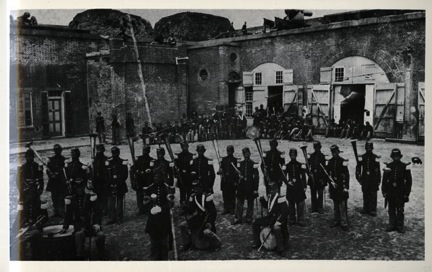Hidden Histories, Historical Marker Resource
History of Emancipation: Gen. David Hunter and General Orders No. 7

This Hidden History was created by SCAD student Erica Corso as part of her SCAD art history department coursework, with guidance from art history professor Holly Goldstein, Ph.D., in 2015.
The History of Emancipation: Gen. David Hunter and General Orders No. 7 historical marker was dedicated in 1955. View the History of Emancipation: Gen. David Hunter and General Orders No. 7 historical marker listing.
Gallery
1. Slaves on Fort Pulaski wearing old Union uniforms, living in outbuilding around the fort. Historical image reinterpreted into painting by author Erica Corso. Copyright Erica Corso, 2015.
2. Some of the first black soldiers. Historical image reinterpreted into painting by author Erica Corso. Copyright Erica Corso, 2015.
3. Contemporary image of marker at Fort Pulaski. Photograph by author Erica Corso. Copyright Erica Corso, 2015.
4. Contemporary image of view from the top of the fort, overseeing the island. Photograph by author Erica Corso. Copyright Erica Corso, 2015.
5. “Cumberland Landing, Virginia. Group of ‘contrabands’ at Foller's house.” Photograph by James F. Gibson. Published May 14, 1862. Courtesy of Library of Congress Prints and Photographs Division.
6. ”Culpeper, Virginia. ‘Contrabands’; Shows two African American men sitting in front of a tent, one with cigar and the other with a soup ladle." Photograph by Timothy H. O'Sullivan. Published November Courtesy of Library of Congress Prints and Photographs Division.
7. “Port Royal Island, S.C. African Americans preparing cotton for the gin on Smith's plantation; Navy, and seaborne expeditions against the Atlantic Coast of the Confederacy, specifically of Port Royal, S.C., 1861-1862. Shows seven African Americans sitting in a pile of cotton in front of gin house.” Photograph by Timothy H. O’Sullivan. Published 1862. Courtesy of Library of Congress Prints and Photographs Division.
8. “Bermuda Hundred, Virginia. African-American teamsters near the signal tower; Shows group of seven "contrabands" dressed in old Union uniforms standing in front of a wagon and shack.” Published 1864. Courtesy of Library of Congress Prints and Photographs Division.
9.“City Point, Virginia. African American army cook at work.’ Published between 1860 and 1865. Courtesy of Library of Congress Prints and Photographs Division.
10. "Deacon March Haynes" Schomburg Center for Research in Black Culture, Manuscripts, Archives and Rare Books Division, The New York Public Library. Courtesy of New York Public Library Digital Collections.
11. “We had an admirable band, whose music was our inspiration in the daily drills and parade- Palmer.” A collection of Fort Pulaski portraits” Text by Rusty Fleetwood. Civil War era photographs of Fort Pulaski, Cockspur Island, Georgia. Courtesy of the Georgia Historical Society, 118.
12. Image shows Ft Pulaski’s neighboring village in the background. “So the days went rapidly by, the nights also, unless you were on guard: then they were long enough, for nothing ever happened to break their tedious length -Palmer.” A collection of Fort Pulaski portraits” Text by Rusty Fleetwood. Civil War era photographs of Fort Pulaski, Cockspur Island, Georgia. Courtesy of the Georgia Historical Society, 103.
13. “A collection of Fort Pulaski portraits” Text by Rusty Fleetwood. Civil War era photographs of Fort Pulaski, Cockspur Island, Georgia. Courtesy of the Georgia Historical Society.
Elmore, Charles J. General David Hunter’s Proclamation: The Quest for African-American Freedom Before and During the Civil War. (Fort Washington, PA: Eastern National Park, 2002).
“From Slave to Soldier on the Georgia Coast.” National Park Service US Department of the Interior Fort Pulaski National Monument. http://www.nps.gov/fopu/planyourvisit/upload/slavetosoldier-final.pdf
Morgan, Philip, ed. African American Life in the Georgia Lowcountry: The Atlantic World and the Gullah Geechee. Reprint edition. (Athens, GA: University of Georgia Press, 2011.)
“Proclamation by Abraham Lincoln” 19 May 1862, #90, Presidential Proclamations, series 23 Record Group 11, National Archives. Published in The Destruction of Slavery, pp. 123–25, and in Free at Last, pp. 46–48. http://www.freedmen.umd.edu/hunter.htm.
“Slavery: Cause and Catalyst of the Civil War.” US Department of the Interior National Park Service. NPS Collection; Southeast Region, Division of Interpretation and Education.
Taylor, Susie King. A Black Woman’s Civil War Memoirs: Reminiscences of My Life in Camp With the 33rd U.S. Colored Troops, Late 1st South Carolina Volunteers. Edited by Patricia W. Romero. 1st edition. (New York: Markus Wiener, 1988).
“Underground Railroad.” Fort Pulaski National Monument, Georgia. National Park Service. US Department of the Interior. http://www.nps.gov/fopu/learn/historyculture/underground-railroad.htm.
Westwood, Howard C. “Generals David Hunter and Rufus Saxton and Black Soldiers” The South Carolina Historical Magazine, Vol. 86, No. 3 (Jul., 1985), pp. 165-181. Published by South Carolina Historical Society. http://www.jstor.org/stable/27567905.
